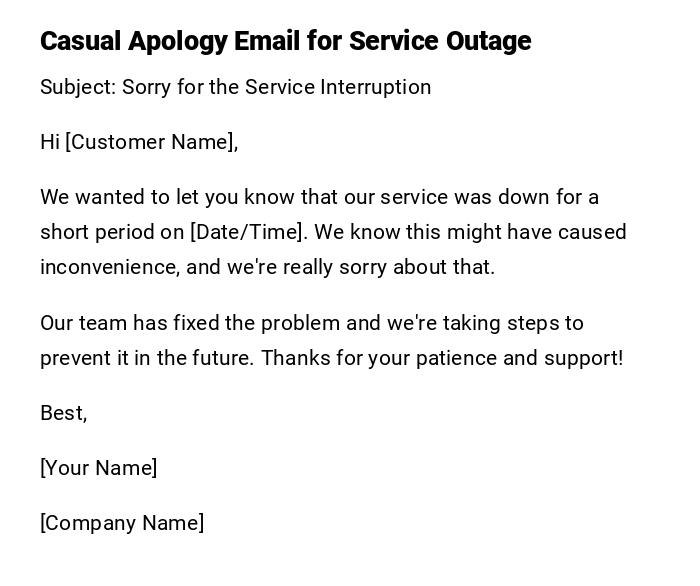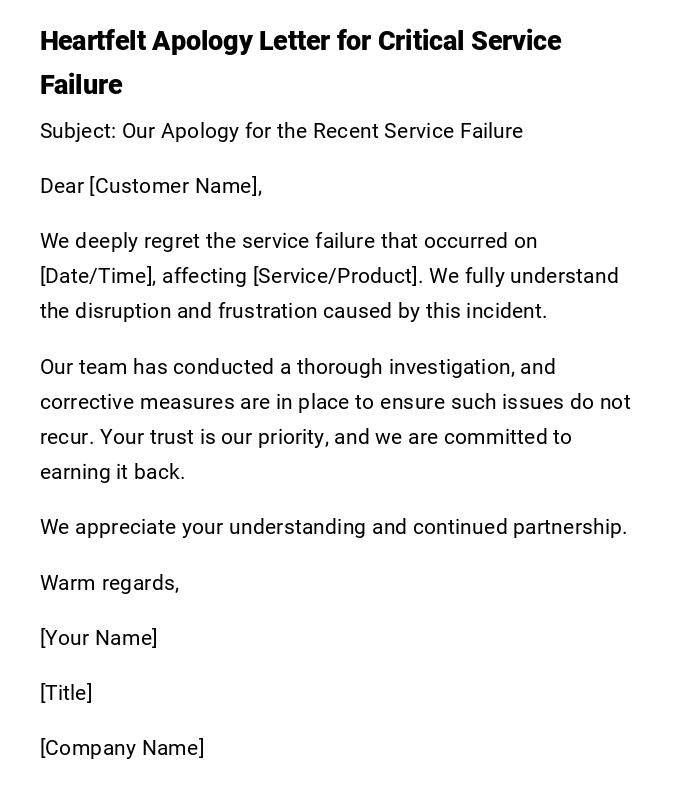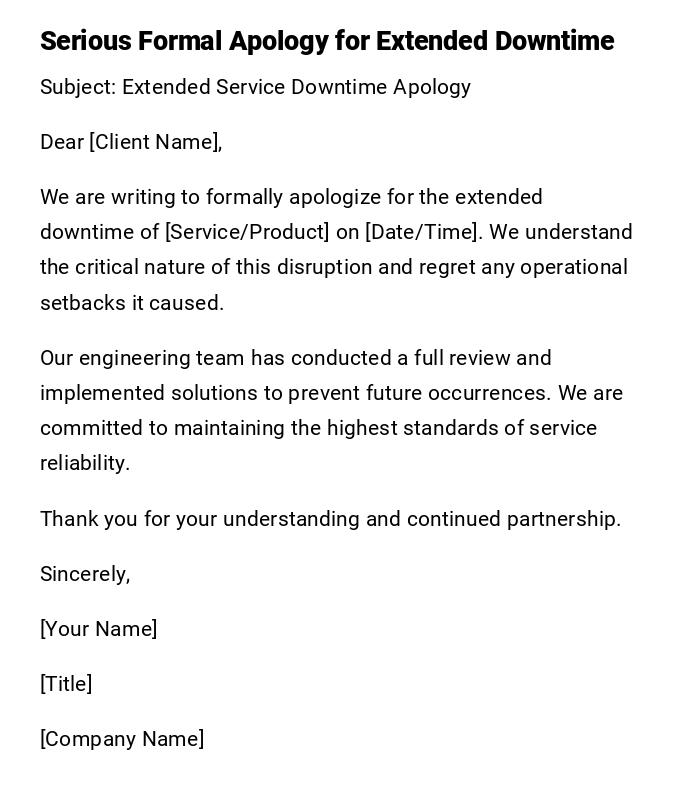Apology Letter for System Downtime or Service Failure
Dear [Recipient's Name],
Subject: Apology for System Downtime or Service Failure
I hope this letter finds you well. I am writing to sincerely apologize for the recent system downtime or service failure that occurred at [Your Organization]. We understand the inconvenience and frustration this may have caused you and deeply regret any disruption it may have caused to your operations.
At [Your Organization], we strive to provide reliable and high-quality services to our valued customers, and we deeply regret that we fell short of your expectations on this occasion. We take full responsibility for the situation and assure you that we are taking immediate action to rectify the issue and prevent its recurrence in the future.
The system downtime or service failure was the result of [briefly explain the cause or issue]. We have conducted a thorough investigation into the matter to identify the root cause and have implemented necessary measures to prevent similar incidents in the future. Our technical team is working diligently to restore the system/service to its normal functionality as quickly as possible.
We understand the impact this may have had on your business and we are committed to making it right. In light of this incident, we would like to offer our sincerest apologies along with [compensation or remediation plan, if applicable]. We value your business and the trust you have placed in us, and we are determined to regain your confidence.
Additionally, we would like to assure you that we are proactively reviewing our systems, processes, and infrastructure to strengthen their resilience and minimize the likelihood of any future disruptions. We have already implemented additional measures to improve our monitoring capabilities, enhance redundancy, and provide better communication channels to keep you informed during any future incidents.
Once again, please accept our deepest apologies for the inconvenience and disruption caused. We genuinely appreciate your understanding and patience throughout this situation. If you have any questions, concerns, or require any further assistance, please do not hesitate to reach out to our dedicated support team at [contact details].
Thank you for your continued support and trust in [Your Organization]. We value our relationship with you and remain committed to serving you with the highest standards of reliability and excellence.
Yours sincerely,
[Your Name]
[Your Position]
[Your Organization]
Formal Apology Letter for System Downtime
Subject: Apology for System Downtime
Dear Valued Customer,
We sincerely apologize for the unexpected system downtime that occurred on [Date/Time]. We understand the inconvenience this has caused and deeply regret any disruption to your operations.
Our technical team has identified the issue and implemented measures to prevent recurrence. We are committed to providing reliable services and appreciate your understanding.
Thank you for your patience and continued trust in [Company Name].
Sincerely,
[Your Name]
[Title]
[Company Name]
Casual Apology Email for Service Outage
Subject: Sorry for the Service Interruption
Hi [Customer Name],
We wanted to let you know that our service was down for a short period on [Date/Time]. We know this might have caused inconvenience, and we're really sorry about that.
Our team has fixed the problem and we're taking steps to prevent it in the future. Thanks for your patience and support!
Best,
[Your Name]
[Company Name]
Heartfelt Apology Letter for Critical Service Failure
Subject: Our Apology for the Recent Service Failure
Dear [Customer Name],
We deeply regret the service failure that occurred on [Date/Time], affecting [Service/Product]. We fully understand the disruption and frustration caused by this incident.
Our team has conducted a thorough investigation, and corrective measures are in place to ensure such issues do not recur. Your trust is our priority, and we are committed to earning it back.
We appreciate your understanding and continued partnership.
Warm regards,
[Your Name]
[Title]
[Company Name]
Quick Notification Message for Temporary Downtime
Subject: Temporary Downtime Apology
Hello [Customer Name],
We experienced temporary downtime on [Date/Time]. We're sorry for any inconvenience this caused.
The issue has been resolved, and our systems are now fully operational. Thank you for your patience.
[Company Name] Team
Official Corporate Apology Letter
Subject: Apology for Service Disruption
Dear [Client Name],
On [Date/Time], [Company Name] experienced an unexpected service disruption affecting [specific services]. We sincerely apologize for the inconvenience and the impact on your operations.
We have identified the root cause and implemented preventive measures. Ensuring reliable and uninterrupted service is our utmost priority, and we deeply value your continued trust.
Sincerely,
[Your Name]
[Title]
[Company Name]
Creative Apology Email for Unexpected Outage
Subject: Oops! Our Service Took a Short Break
Hey [Customer Name],
Looks like our systems decided to take an unscheduled nap on [Date/Time]. We're really sorry for the inconvenience this caused!
The good news: everything is back online and running smoothly. We appreciate your patience and promise to keep our service awake next time!
Cheers,
[Your Name]
[Company Name]
Serious Formal Apology for Extended Downtime
Subject: Extended Service Downtime Apology
Dear [Client Name],
We are writing to formally apologize for the extended downtime of [Service/Product] on [Date/Time]. We understand the critical nature of this disruption and regret any operational setbacks it caused.
Our engineering team has conducted a full review and implemented solutions to prevent future occurrences. We are committed to maintaining the highest standards of service reliability.
Thank you for your understanding and continued partnership.
Sincerely,
[Your Name]
[Title]
[Company Name]
What is an Apology Letter for System Downtime or Service Failure and Why It Matters
- A formal or informal communication acknowledging system downtime or service failure.
- Purpose: To inform users, express regret, and maintain trust.
- Helps manage customer expectations and prevent reputational damage.
Who Should Send an Apology Letter for Service Failure
- Customer support teams.
- IT or technical departments responsible for service maintenance.
- Senior management in cases of critical impact.
Whom Should an Apology Letter Be Addressed To
- End users experiencing the service disruption.
- Corporate clients affected by downtime.
- Partners or stakeholders dependent on service availability.
When to Send an Apology Letter for System Downtime
- Immediately after a temporary or extended service interruption.
- Following a significant system failure impacting clients.
- After the issue has been resolved and corrective measures are implemented.
How to Write and Send an Effective Apology Letter
- Acknowledge the issue clearly.
- Express sincere regret without assigning blame.
- Explain the cause (briefly) and corrective actions.
- Provide reassurance about future reliability.
- Send via email for rapid communication or letter for formal corporate contexts.
Requirements and Prerequisites Before Sending
- Accurate details about downtime or service failure.
- Timeline of events and resolution status.
- Contact information for recipients.
- Internal approval for tone and wording in official letters.
Formatting Guidelines for Apology Letters
- Tone: Professional, sincere, and empathetic.
- Length: Concise, ideally one page.
- Structure: Subject, greeting, acknowledgment, apology, explanation, resolution, closing.
- Use bullet points for clarity if listing impacted services or actions.
Tricks and Tips for Crafting Apology Letters
- Send promptly to maintain credibility.
- Customize for audience type (corporate vs. individual).
- Offer compensation or support if applicable.
- Avoid technical jargon for general users.
- Follow up with status updates if issue persists.
Common Mistakes to Avoid
- Delaying communication after downtime.
- Using vague or non-apologetic language.
- Blaming customers or external factors.
- Failing to explain corrective measures.
- Ignoring follow-up or monitoring responses.
Elements and Structure of an Effective Apology Letter
- Subject line indicating apology or acknowledgment of downtime.
- Salutation addressing the recipient.
- Clear statement acknowledging the issue.
- Expression of sincere apology.
- Brief explanation of cause and corrective action.
- Assurance of future reliability.
- Contact information for queries.
- Professional closing and signature.
After Sending the Apology Letter: Follow-Up Actions
- Monitor for customer responses or complaints.
- Provide updates on service stability if needed.
- Document the communication for internal records.
- Implement feedback and ensure corrective measures are effective.
Pros and Cons of Sending Apology Letters for Service Failures
Pros:
- Maintains trust and credibility.
- Reduces customer frustration by acknowledging the problem.
- Shows commitment to service quality.
Cons:
- May highlight system vulnerabilities.
- Requires careful wording to avoid liability or blame.
- Needs timely follow-up to be effective.
Compare and Contrast with Other Customer Communication Methods
- Unlike social media notifications, letters provide formal acknowledgment.
- Email allows immediate communication while printed letters offer professionalism.
- Phone calls can supplement letters for high-impact outages but may lack documentation.









 Download Word Doc
Download Word Doc
 Download PDF
Download PDF